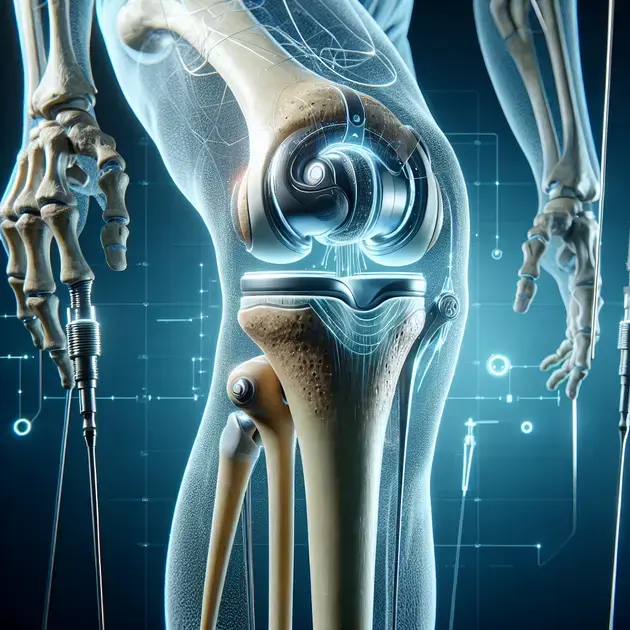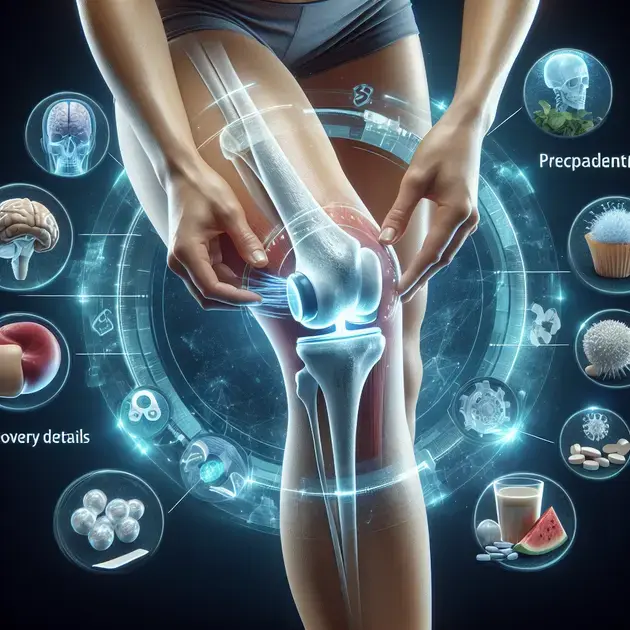If you are considering knee replacement surgery, this ultimate guide is essential reading. The advancements in modern medicine have made knee replacements a common and highly successful procedure for those suffering from chronic knee pain or injuries.
From pre-surgery preparations to post-operative care, this comprehensive guide covers everything you need to know about knee replacements. Stay informed and prepared to make the best decisions for your health and well-being.
Preparing for Knee Replacement Surgery
Preparing for knee replacement surgery is a crucial step to ensure a successful outcome. Here is a step-by-step guide on how to prepare for the procedure:
Educate Yourself:
Start by researching about knee replacement surgery on reputable medical websites such as Mayo Clinic or WebMD. Understanding the procedure, risks, and benefits will help you make informed decisions.
Consult with Your Doctor:
Schedule a consultation with your orthopedic surgeon to discuss your options and address any concerns you may have. Your doctor will evaluate your medical history and conduct necessary tests before proceeding with the surgery.
Prepare Your Home:
Make your home safe and accessible for your recovery period. Consider installing handrails, raised toilet seats, and removing obstacles that may cause accidents. You can find a comprehensive checklist on home preparation on the Arthritis Foundation website.
Arrange for Support:
Inform your family and friends about your upcoming surgery and discuss the support you may need during your recovery. You can also explore support groups online, such as the CreakyJoints community, to connect with others undergoing similar procedures.
Follow Pre-Op Instructions:
Adhere to the pre-operative instructions provided by your healthcare team. This may include fasting before surgery, stopping certain medications, and following specific guidelines to reduce the risk of complications during the procedure.
Understanding the Procedure and Recovery Process
Having a clear understanding of the knee replacement surgery procedure and the recovery process is essential for a smooth recovery. Here is a breakdown of what to expect:
The Procedure:
The knee replacement surgery involves removing damaged parts of the knee joint and replacing them with artificial components. Detailed information on the surgical procedure can be found on the American Academy of Orthopaedic Surgeons (AAOS) website.
Recovery Timeline:
Recovery from knee replacement surgery can vary for each individual, but a general timeline can help you prepare. The AAOS website provides a comprehensive guide on the expected recovery milestones, physical therapy duration, and tips for a successful rehabilitation.
Pain Management:
Managing pain post-surgery is crucial for a comfortable recovery. Your healthcare team will provide pain medication and recommend strategies such as icing, elevation, and physical therapy exercises. Stay in touch with your medical providers and report any unusual pain or discomfort.
Physical Therapy:
Engaging in physical therapy is vital for regaining strength and mobility in your knee. Your physical therapist will design a personalized rehabilitation plan to help you gradually regain functional movement. Apps like MyRehabApp can assist in tracking your exercises and progress.
Follow-Up Care:
After the surgery, regular follow-up appointments with your surgeon are essential to monitor your progress and address any concerns. Your healthcare team will guide you on post-operative care, activity restrictions, and steps to ensure the longevity of your knee replacement.
Tips for a Successful Rehabilitation
Rehabilitation plays a crucial role in the recovery process after knee replacement surgery. Here are some tips to enhance your rehabilitation experience:
Stay Committed to Therapy:
Consistency is key in rehabilitation. Follow your physical therapist’s recommendations diligently and complete your exercises as prescribed. Use apps like Physitrack to access exercise videos and track your progress.
Focus on Nutrition:
Eating a balanced diet rich in nutrients can support your recovery and promote healing. Consult a nutritionist or use apps like MyFitnessPal to track your food intake and ensure you are getting essential vitamins and minerals.
Stay Active:
Engage in low-impact activities such as swimming or walking to improve circulation and strengthen your muscles. Monitor your activity levels with a fitness tracker like Fitbit and set achievable goals for gradual progress.
Maintain a Positive Mindset:
Recovery can be challenging, but maintaining a positive attitude can improve your overall well-being. Join online forums like HealthUnlocked to connect with individuals sharing similar experiences and gain support.
Patience and Rest:
Listen to your body and give yourself time to rest and recuperate. Adequate sleep and relaxation are essential for your body to heal effectively. Use mindfulness apps like Calm to practice relaxation techniques and reduce stress during your recovery journey.
Understanding the Risks and Complications of Knee Replacements
When considering knee replacement surgery, it is important for patients to understand the potential risks and complications associated with the procedure. While knee replacements are generally safe and effective, like any surgery, there are inherent risks involved. Common risks include infection, blood clots, nerve damage, and prosthesis failure. Patients should discuss these risks thoroughly with their healthcare provider before proceeding with surgery.
One of the most serious complications of knee replacement surgery is infection. Infections can occur either at the surgical site or within the joint itself. Symptoms of an infection may include increased pain, swelling, redness, or warmth around the knee. In some cases, surgery may be required to treat the infection and prevent further complications.
Another potential risk of knee replacement surgery is blood clots. Blood clots can form in the veins of the legs and travel to the lungs, causing a condition known as pulmonary embolism. To reduce the risk of blood clots, patients may be advised to wear compression stockings, take blood-thinning medications, and engage in early mobilization post-surgery.
Nerve damage is a less common but possible complication of knee replacement surgery. Nerve injury can lead to numbness, weakness, or pain in the affected leg. In most cases, nerve damage is temporary and resolves on its own over time. However, in some instances, persistent nerve damage may require additional treatment.
Lastly, prosthesis failure is a rare but serious complication that may occur years after knee replacement surgery. Factors such as wear and tear, loosening of components, or infection can contribute to prosthesis failure. Patients should be aware of the signs of prosthesis failure, such as increasing pain or instability in the knee, and seek prompt medical attention if any concerns arise.
Nutrition and Exercise Recommendations Before and After Surgery
Before Surgery:
Prior to knee replacement surgery, maintaining a healthy diet and engaging in regular exercise can help optimize the outcomes of the procedure. A balanced diet rich in fruits, vegetables, lean proteins, and whole grains can support the body’s healing process. Additionally, staying physically active with low-impact exercises like swimming or cycling can help strengthen the muscles around the knee, improving overall mobility.
After Surgery:
Following knee replacement surgery, proper nutrition and exercise are essential for a successful recovery. Adequate protein intake is crucial for tissue healing and muscle strength. Vitamin C and D are also important for bone health and immune function. Patients should work with a healthcare provider or nutritionist to develop a customized meal plan that meets their specific needs post-surgery. As for exercise, a physical therapy program tailored to the individual’s recovery plan can help restore range of motion, flexibility, and strength in the affected knee.
Innovations in Knee Replacement Technology
Advancements in knee replacement technology have revolutionized the way these surgeries are performed, leading to improved outcomes and faster recovery times for patients. One innovative technology that is gaining popularity is robotic-assisted knee replacement surgery. This technology allows surgeons to create a 3D model of the patient’s knee anatomy, enabling more precise placement of the prosthesis for better alignment and stability.
Another groundbreaking innovation is the use of 3D-printed implants in knee replacement surgery. These custom-made implants are designed based on the patient’s unique anatomy, offering a more tailored fit and potentially reducing the risk of complications such as implant loosening or wear.
Furthermore, advancements in materials used for knee implants, such as ceramic or metal alloys, have improved the durability and longevity of prosthetic knees. These materials are designed to withstand the demands of daily activities and provide long-lasting functionality to the patient.
Overall, the continuous evolution of knee replacement technology underscores the commitment of medical professionals to enhance patient care and outcomes in orthopedic surgery. Patients considering knee replacement should discuss these innovative technologies with their healthcare provider to determine the most suitable approach for their specific needs.
Conclusion
In conclusion, when contemplating knee replacement surgery, understanding the risks and complications associated with the procedure is vital. While the surgery is generally safe and effective, it is crucial for patients to be aware of potential complications such as infections, blood clots, nerve damage, and prosthesis failure. Thorough discussions with healthcare providers can help patients make informed decisions regarding their treatment.
Prior to surgery, focusing on nutrition and exercise can optimize post-operative outcomes. A balanced diet rich in essential nutrients and engaging in low-impact exercises can aid in healing and enhance overall mobility. After surgery, proper nutrition, especially adequate protein intake, and a tailored exercise program are essential for successful recovery, helping restore strength and range of motion in the affected knee.
Advancements in knee replacement technology have significantly improved surgical outcomes and patient recovery. Technologies like robotic-assisted surgery and 3D-printed implants have revolutionized the way knee replacements are performed, offering more precise placement and customized implants to reduce complications. Additionally, the use of advanced materials in knee implants enhances durability and functionality, catering to the demands of daily activities and providing long-term benefits to patients.

